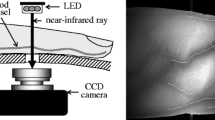Abstract
Five male Japanese subjects, undressed, were investigated at rest and during ergometer work at 30°, 25°, 20°, 15° and 10°C and the results were compared with similar measurements on Caucasians. The metabolic rate and mean skin temperature were higher at temperatures below 20°C than in Caucasians, while the correlation curve of metabolic rate versus skin temperature was similar. The rectal temperature decreased with lowering of the air temperature in these subjects in contrast to the observations in Caucasians. The thermal conductance of the Japanese was higher at the control air temperature, but became lower or equal in cool air as compared with that of Caucasians. The lower critical temperature was around 24°C. The results indicate that Japanese men react to cold with a mixture of both metabolic and insulative adaptation which differs from the response of Caucasians. The difference may be due to the environment, living habits and bodily constitution.
Zusammenfassung
Fünf Japaner wurden unbekleidet in Ruhe und während Ergometerarbeit bei 30°, 25°, 20°, 15° und 10°C Raumtemperatur untersucht und die Ergebnisse mit ähnlichen Untersuchungen an Personen der weissen Rasse (Kaukasiern) verglichen. Stoffwechselrate und mittlere Hauttemperatur waren unterhalb 20°C bei den Japanern höher als bei den Kaukasiern, während die Korrelationskurve der Stoffwechselrate versus Hauttemperatur gleich waren. Die Rektaltemperatur fiel bei den Japanern mit Senkung der Lufttemperatur ab, umgekehrt zu den Beobachtungen an Kaukasiern. Die Wärmeleitung war bei den Japanern höher im Bereich der Temperaturen bis 25°C, dagegen in kühler Luft niedriger oder blieb auf dem gleichen Niveau beim Vergleich mit den Werten von Kaukasiern. Die untere kritische Temperatur war 24°C. Die Ergebnisse zeigen, dass Japaner auf Kälte mit metabolischer und insulativer Adaptation reagieren, anders als Kaukasier. Diese Unterschiede können Ausdruck der Lebensgewohnheiten, Umweltbedingungen und der Konstitution sein.
Resume
Cinq Japonais ont été examinés nus au repos et au travail à l'ergomètre par des températures ambiantes de 30°, 25°, 20°, 15° et 10°C. On a comparê les reléves ainsi effectués avec ceux provenant de personnes de race blanche (Caucasiens). Le métabolisme et la température cutanée moyenne furent, au dessus de 20°C, plus élevés chez les Japonais que chez les Caucasiens, alors que le rapport métabolisme-température cutanée restait identique. La température rectale a baissé chez les Japonais avec un refroidissement extérieur, contrairement à ce qui se passait chez les Caucasiens. La conductibilité thermique fut plus élevée chez les Japonais pour des températures supérieures à 25°C et diminua ou resta stationnaire dans de l'air plus frais — tous ces chiffres sont relatifs aux valeurs relevées sur les Caucasiens. La température critique inférieure se situe à 24°C. Ces résultats montrent que les Japonais réagissent autrement au froid que les Caucasiens, c'est à dire que leur adaptation métabolique et insulative est différente. Ces différences peuvent résulter de leur manière de vivre, des conditions ambiantes ou de leur constitution.
Similar content being viewed by others
References
ADAMS, T. and COVINO, B.G. (1958): Racial variations to a standardized cold stress. J.appl.Physiol., 12: 9–12.
COMMITTEE OF NATURAL RESOURCE (1959): Nutritional requirement of the Japanese. National Academy of Science and Technique. Daiichi-shupan Co., Tokyo.
ERIKSON, H., KROG, J., ANDERSEN, K.L. and Scholander, P.F. (1956): The critical temperature in naked man. Acta Physiol. scand., 37: 35–39.
HARDY, J.D. and DUBOIS, E.F. (1940): Differences between men and women in their response to heat and cold. Proc.nat.Acad.Sci.(Wash.), 26: 389–398.
LEBLANC, J. (1957): Prefeeding of high fat diet and resistance of rats to intense cold. Canad.J.Biochem., 35: 25–30.
MAKIHATA, K. (1960): Seasonal variation of resistance to cold. Nisshin Igaku, 417: 533–545.
SCHOLANDER, P.F., HOCK, R., WALTERS, V., JOHNSON, F. and IRVING, L. (1950): Heat regulation in some arctic and tropical mammals and birds. Biol.Bull., 99: 237–258.
SCHOLANDER, P.F., ANDERSEN, K.L., KROG, J., LORENTZEN, F.V. and STEEN, J. (1957): Critical temperature in Lapps. J.appl.Physiol., 10: 2311–234.
SCHOLANDER, P.F., HAMMEL, H.T., ANDERSEN, K.L. and LOYNING, Y. (1958a): Metabolic acclimation to cold in man. J.appl.Physiol., 12: 1–8.
SCHOLANDER, P.F., HAMMEL, H.T., HART, J.S., LEMESSURIER, D.H. and STEEN, J. (1958b): Cold adaptation in Australian Aborigines. J. appl. Physiol., 13: 211–218.
WYNDHAM, C.H., WARD, J.S., STRYDOM, N.B., MORRISON, J.F., WILLIAMS, C.G., BREDELL, G.A.G., PETER, J., VON RAHEN, M.J.E., HOLDSWORTH, L.D., VANGRAAN, C.H., VAN RENSBURG, A.J. and MUNRO, A. (1964): Physiological reactions of Caucasian and Bantu males in acute exposure to cold. J.appl.Physiol., 19: 583–592.
YOSHIMURA, H. and WEINER, J.S. (ed.) (1966): Human Adaptability and its Methodology. Japan Society for the Promotion of Sciences. Maruzen Co., Tokyo.
YOSHIMURA, H., USAMI, S., MAKIHATA, K. and SHIOMI, S. (1962): Nature of resistance to cold and its individual difference. J.Physiol.Soc.Japan, 24: 81–94.
YOSHIMURA, M. and HORVATH, S.M. (1967): Change of basal metabolism in Japanese at USA. In: Report to Seminar on fundamental problem of the biological rhythm of the human ecosystem. US-Japan Scientific cooperative program. Kyoto, 49–50.
YOSHIMURA, M., TAKEDA, H. and YOSHIMURA, H. (1969): Effect of dietary composition on thermal acclimation. J.Physiol.Soc.Japan, 31: 178–179.
YOSHIMURA, M., YUKIYOSHI, K., YOSHIOKA, T. and TAKEDA, H. (1966): Climatic adaptation of basal metabolism. Fed.Proc., 25: 1169–1174.
Author information
Authors and Affiliations
Rights and permissions
About this article
Cite this article
Yoshimura, M., Yoshimura, H. Cold tolerance and critical temperature of the Japanese. Int J Biometeorol 13, 163–172 (1969). https://doi.org/10.1007/BF01552737
Received:
Issue Date:
DOI: https://doi.org/10.1007/BF01552737



